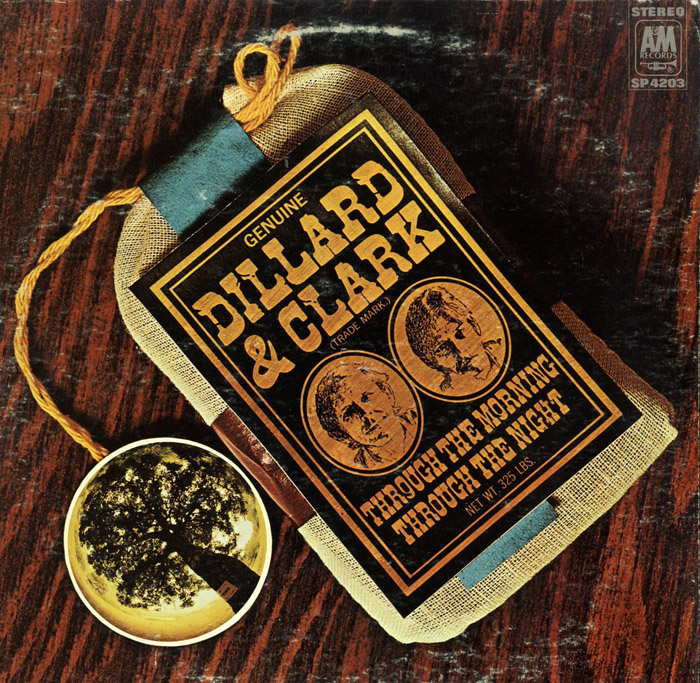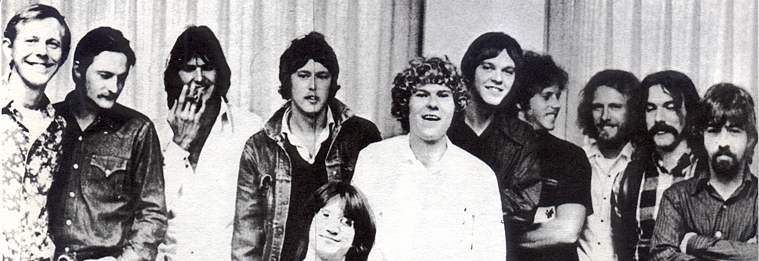I'm a sucker for that rootsy blend of country, bluegrass, folk and rock that was LA “Country Rock” circa 1968-69… but I've always had a nagging doubt about those early years, and that doubt has grown over time due to throw-away lines in reviews, biographies and documentaries.
The thing is, LA Country Rock (like so much of rock, really) seems to be a boys-only club. More worryingly, some of that attitude seems to have passed down through the ages where it still continues to effect how some albums are appreciated.
Take the 2nd Dillard & Clark Album for example…
 You may or may not have heard of Dillard & Clark. You may have heard hip references to their genre defining first album “The Fantastic Expedition of Dillard & Clark”.
You may or may not have heard of Dillard & Clark. You may have heard hip references to their genre defining first album “The Fantastic Expedition of Dillard & Clark”.
Quite recently Robert Plant & Alison Krauss found critical and commercial success when they covered a couple of Dillard & Clark songs. You may even have read a passing mention about a disappointing second album and the hasty end of the group.
Second Album
“Through the Morning, Through the Night” was that second and last album from the group… I want to take a few minutes to redress the dismissal of that album and perhaps shine a light on what I think could be Country Rocks' larger “boys-club” biographical problem.
Dillard & Clark were the quintessential late 60's pioneering country rock 'n bluegrass group formed by Gene Clark (2 years after leaving The Byrds for first time… a few months after his second 3 week stint!) and Doug Dillard, a crack banjo player from The Dillards. The group initially featured erstwhile future Eagle, Bernie Leadon on guitar along with bass player Dave Jackson and mandolin player Don Beck.
For the second album the band was joined by fiddle player Byron Berline (who had worked with Dillard on a couple “The Dillards” LPs) so the lineup was Gene Clark (vocals/guitar/harmonica), Doug Dillard (banjo/fiddle/guitar/vocals), Donna Washburn (guitar/vocals), Byron Berline (fiddle) David Jackson (bass/piano) and John Corneal (drums).
Better
To me, the second album actually means more to me than the first. After years of listening to both albums (and as I have grown older), my love for the second album has grown too.
Everything still seems authentically “rootsy” but it is also less tragically hip than what went before. It is missing that holistic acoustic vision of the first album but it IS a more human record. It doesn't remain in some 60's fantasy world like that first album.
Crucially, the introduction of Donna Washburn, (a female harmony vocalist and girlfriend of Doug) takes the whole album to a different level. Some of the duets and harmony lines are simply joyous, others are utterly heartbreaking. They still sound fresh and distinctive to these ears because they aren't 100% authentic or “try-hard” (they also pre-empt the Gram Parson and Emmylou Harris harmonies by 2 or so years).
Also… it does have the better songs. These include the stand out original versions of the two Plant & Krauss covers, “Polly” and “Through the morning, through the night”. These beautiful slow country ballads were inexplicably slowed down even more by Plant & Krauss (in that mid 2000's trend for taking a dirge and putting the breaks on). It's safe to say that the originals are best.
This wonderful second album also has what may be my all time favorite cover of a Beatles song, plus a truly wonderful reading of “So Sad” …and I even like the straight-out bluegrass interludes and the Ringo-esque Dillard lead vocal!
So, all-in-all, the second album IS a fractured mess… but this makes it all the more fascinating. It feels more fun, more authentic, more human and yet more contemporary (even today) than that lauded first album or almost everything else that other proto-country rockers were doing at the time.
So yes, I love the second Dillard & Clark album. But (and here is my real point) over the years so many people are happy to quickly pass over it. Why?
Dismissed
At first, I too was a second album denier. “Where is the hip cosmic-bluegrass music from the first album?”, “This sounds all together like straight country music to me.” and “Is that… a GIRL singing?”. But then I listened to the music… grew up… and listened again. And now I love the second Dillard & Clark album to bits.
So why is this 2nd album so quickly dismissed among the country rock Illuminati? Was it purely because it was the last album and didn't live up to the high expectation of the first?
Not exactly! Barely anyone listened to any any of these albums at the time. Recognition only came years later when biographers and students of the genre were looking back for some sort of Country Rock genesis.
Was it because the Gene Clark hated the album and wanted to move on?
Possibly. In late 60's LA groups were splintering and forming every 5 seconds… But the fact that the visionary (and somewhat troubled) leader left the group after an album or two should not detract from what is on record. The fact that some people involved in a project were not entirely happy with the end result should also not cloud our views. Everyone is human. Everyone has some axes! Biographies putting words in Clarks eternal mouth saying he was “not interested” in the new less-rootsy, less-acoustic sound are also not entirely helpful. We all change our minds or spout off from time to time.
Wisdom
Sometimes rock biographies do everyone a disservice. Sometimes you have to follow the music and not the personalities. Is the music actually any good? (Remember that even your heroes can be full of crap! I'm looking at you Arthur Lee with your 70 and 80's Forever Changes bashing! …or you, John Lennon, with some of your 70's outbursts!).
The second Dillard & Clark album highlights a certain kind of male-only group dynamic that overlays so much of rock. Group members and die-hard fans display a hostile suspicion towards the evil distracting influences of a WOMAN in the inner sanctum of this all boys club. These women were all very well if they were cheer-leading girlfriend or groupies… but joining the group? Yuck.
Boys Club
This boys-club attitude seems to be accepted by biographers and fans a-like. In fact the whole Dillard & Clark section from “Mr. Tambourine Man: The Life And Legacy Of The Byrds’ Gene Clark by John Einarson” is worth reading and digesting properly. Far from adding to the evidence that the second album was pants, it shines the light squarely on the boys only music club with no comment or self-awareness from the biographer.
The passage begins…
Douglas had hooked up with Donna Washburn, whose father was a prominent executive with the 7-Up soft drink company, and insisted she now join the group as the third voice, a role previously held by Bernie “She was a lovely person, a very attractive blond young woman” recounts Bernie, “but she wanted to sing, too. She and Douglas were sort of an item. So Donna's there all the time and when we start singing she goes to the third part, which was the part I Sing. So I figured I'm suddenly redundant. It was totally over for me, but it was clear it would never be a working band. So I opted out at that point. Donna had a big personality and was ambitious, but it was like if Yoko Ono showed up and started singing the third part and George Harrison's wondering what's going on. We tried it for one day and I just figured it wasn't working, so I left. There were only three parts in the harmonies'
A “lovely person” BUT.SHE.WANTED.TO.SING. Gasp!
A toy-throwing Bernie Leadon had to get the hell out of the group as quickly as possible. “She's taken my harmony part” he sulked. I mean he gave it a whole day…
It continues with the emotionally scarred bass player (who seems to inhabit the brain of a 9 year old)
“Donna sort of placed herself in that situation and Douglas allowed it; muses David. “Douglas allowed his women, all of whom were strong Women, to be a part of his life in a fashion that he really shouldn't have. That's just his nature, just the way he is. I remember thinking there is no reason for this girl to be here. She's a delightful lady, but why is she ingratiating herself into this music that doesn't need this ingratiation? I guess there were some things that were better, some of the harmonies were interesting, but I personally didn't think that was of any great import to the needs of this music.”
See. Strong women NOT ALLOWED in this boys club.
It get's worse (from the producer of the album)…
“Larry Marks agrees. It was divisive in more ways than one. It didn't really work musically, but it wasn't going to go away. She was Doug's lady at that point. But she clearly wasn't out of the same briar patch as Doug or Gene. She always looked like Daisy Mae from Beverly Hills, dressing up in those kinds of clothes to be in the band. It just never quit worked because it wasn't real. Gene kind of lived with it, he accepted it, and everybody tried to make it work.”
So all these men in LA dressed as faux cowboys are THE REAL DEAL… but those women… they are fake cos-play demons! You can almost picture the band and producer scoffing as these glorious but oh-so threatening male / female harmonies went on tape.
Nobody knows
Gene “went along with it”, according to the producer, but we don't really know. Maybe the answers were prompted by the hapless biographer. Maybe not.
Maybe Gene heard what we hear and didn't just “go along with it”? Maybe he really liked the result… but perhaps a bunch of sniping band mates and a lack of success made it difficult to carry on? Gene himself was a somewhat fragile soul who self-medicated his fears away (and was rarely interviewed).
Interestingly, Doug was almost the opposite… a hedonistic country boy who seemed always to have a smile on his face and a constant desire to indulge without any visible consequences. He even carried on with “The Expedition” a little while longer after Gene left. Donna also left eventually to go on tour with Leonard Cohen (and others) as a backing singer.
I think Gene and Donna were glorious trailblazers in the use and positioning of their harmonic blend. It still sounds great to my ears today and many of these songs continue to be some of my all time favorite Gene Clark moments. Why the Donna Washburn harmonies and contribution are still so easily dismissed remains a sad indictment of country rock's “boys club”.
I'll end with this great… but suspiciously male picture of the country rock boys-club circa 1969. (That's Doug, Gene, Gram Parsons, Michael Clarke, Richie Furay (sitting), Jon Corneal, Rusty Young, Chris Hillman, “Sneaky” Pete Kleinow, Gene Parsons, Clarence White (Picture from Sid Griffin's Gram Parsons – A Music Biography).
Don't worry boys, soon there will be cocaine… and the Eagles.
There is also some more Donna Washburn info here… 1heckofaguy.com.


You must be logged in to post a comment.